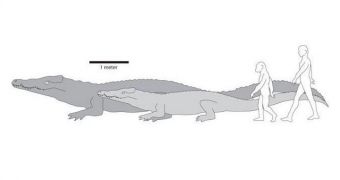Investigators from the University of Iowa announce the discovery of a massive crocodile species that lived in what is now Kenya, East Africa, between 2 and 4 million years ago. The reptile may have grown to around 8.2 meters (27 feet) in length, exceeding the size of the largest known Nile crocodile.
The latter was about 6.4 meters (21 feet) in length, but most individuals in this species are a lot smaller than that. According to Christopher Brochu, the UI associate professor of geosciences who discovered the creature, this was the largest known true crocodile.
He provides additional details about the finding in the May 3 issue of the esteemed scientific Journal of Vertebrate Paleontology. The expert believes that the extinct reptile was very similar to the Nile crocodile, except significantly more massive.
Brochu first came across fossils indicating the new species while studying old remnants of crocodiles at the National Museum of Kenya, in Nairobi, three years ago. What is interesting is that some of these fossils were discovered at sites where ancient human remains were also unearthed.
In the new study, the expert argues that the ancient reptile most likely lived right alongside our distant ancestor, and occasionally fed on them. Since crocodiles are in the habit of eating anything they come across, it's extremely likely that they also ate the 4-foot (1.2-meter) humans that lived at the time.
“We don’t actually have fossil human remains with croc bites, but the crocs were bigger than today’s crocodiles, and we were smaller, so there probably wasn’t much biting involved,” Brochu explains.
In addition, he says, humans did not have their own, protected water sources at the time. Therefore, they must have used the same watering holes as all the other animals, therefore putting themselves at risk of suffering the same kind of crocodile attack as any other creature.
The newly identified species has been named Crocodylus thorbjarnarsoni, in honor of famed crocodile expert John Thorbjarnarson, who fell victim to malaria while studying crocodiles in the field, a few years ago. He was also a friend of Brochu, ScienceDaily reports.
“He was a giant in the field, so it only made sense to name a giant after him. I certainly miss him, and I needed to honor him in some way. I couldn’t not do it,” the investigator concludes.

 14 DAY TRIAL //
14 DAY TRIAL //